Japanese
English
- 有料閲覧
- Abstract 文献概要
- 1ページ目 Look Inside
I.はじめに
脳神経外科領域において,術後痙攣は稀ならず遭遇するものであるが,とりわけ術後早期に起こる痙攣は重篤な神経症状を惹起することがあるため,術前からの抗痙攣剤の予防的投薬や,術直前・術後の非経口投与が行われている,従来,抗痙攣剤の投与は臨床症状とあわせて経験的に行われてきたが,近年,抗痙攣剤の血中濃度測定が容易となり,血中濃度から適切な投与量や投与間隔を決定することが可能となっている3,6,10).しかし,これまでの報告は経口投与についての知見がほとんどであり,開頭術前後の抗痙攣剤の血中濃度の変動や非経口投与下での血中濃度の変化についての知見は充分でない.われわれは術後早期に起こる痙攣を予防するための適切な抗痙攣剤の投与設計をたてるため,まず日常われわれが行っている種々の投与法での抗痙攣剤の血中濃度の経時的変動を検索した.さらに,血中濃度測定中に術後痙攣を起こした6例について,血中濃度と痙攣との相関について検討した.
In the neurosurgical care, postoperativeconvulsion,the especially in the early postoperative course, isoneof major complications because it can spoil anotherwisegood surgical result. The present study was intendedtoinvestigate the prophylactic use of anticonvulsantsonchemical measurement of their plasma levels.Parenteral di-phenylhydantoin (DPH) given just before craniotomyfailedto maintain high level of DPH in the postoperativecourseeven with pretreatment of oral DPH. On the otherhand,preoperative oral phenobarbital administrationmaintainedfairly high level in spite of no prescription on theoperativeday.

Copyright © 1982, Igaku-Shoin Ltd. All rights reserved.


